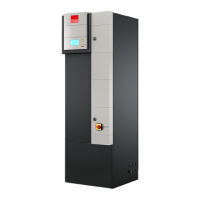
Do you have a question about the Stulz Split-Air CST 40 and is the answer not in the manual?
| Brand | Stulz |
|---|---|
| Model | Split-Air CST 40 |
| Category | Air Conditioner |
| Language | English |
Step-by-step guide for connecting and configuring multiple units in a sequencing network.
How dehumidification works without electric reheat, using fan speed and compressor.
How dehumidification works with electric reheat when temperature difference is high.
Guidelines and checks for correctly positioning the indoor unit within the shelter.
Guidelines for selecting the location and securely installing the outdoor unit.
Detailed instructions for connecting main power, signal, and sensor cables.
Recommended checks for preventive maintenance on a monthly and yearly basis.
Intervals for general overhaul and major service, either at factory or authorized centers.
Recommendations for replacing components based on their MTBF (Mean Time Before Failure).
General safety rules for personnel involved in testing and maintaining the unit.
Details on hazards arising from contact with moving fans or sharp heat exchanger fins.
Information on electrical risks, safety standards, and tasks for plant managers regarding electrical equipment.
Precautions and safety standards to follow when working with refrigerants and refrigeration circuits.
Information on hazards related to refrigerant gas in the presence of flames and preventive measures.
Troubleshooting steps for scenarios where the unit is not cooling effectively or at all.
Troubleshooting steps when the unit's cooling performance is inadequate.











